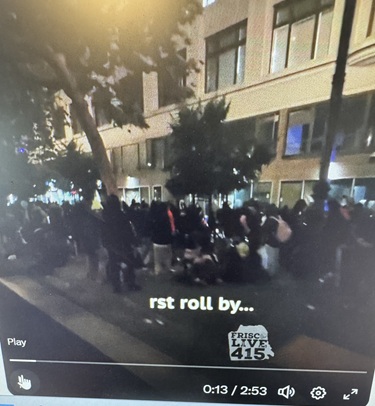
6th and Market, Oct 20, 1:00am
A San Francisco comeback requires reviving Market Street. Hundreds of drug users and dealers inhabit the area after midnight. This must stop. It badly hurts the city’s image and is unfair to Market Street’s hotels, theaters, housing and businesses. The city solved a similar drug crisis at UN Plaza. Why not apply similar strategies to Market Street?
Market Street Has Gotten Worse
After decades of decline, Twitter’s arrival in 2011 began historic Mid-Market’s revival. Market Street was finally on a path toward greatness.
But COVID halted this progress. It arrived at the worst possible time. Multiple developments were under construction and they opened to a pandemic that closed the street down. Market Street between 5th and 9th Streets—historically known as Mid-Market—saw drug activity skyrocket. It was not until UN Plaza and the Pelosi Federal Building were both cleared of open air drug markets that Mid-Market’s progress resumed.
But Mid-Market drug activity from midnight to 6:00 am is off the hook. Videos from October 20 posted on X by FriscoLive415 show a drug scene as bad as the dark days of the Linkage Center. JJ Smith, who regularly videos the Mid-Market drug scene, shows the same scene on October 23 from a different angle . An October 24 video from @TL2Active described the sidewalk-filled drug market as “crazy.”
Drug markets have also expanded on Market between Eighth and Ninth Streets.
So what should the city do?
How about using what worked for clearing UN Plaza? It took two strategies developed by Rec and Parks Director Phil Ginsburg. Both are needed to rescue Mid-Market.
Adding Local Resources
First, more resources are needed. Ginsburg added park rangers to SFPD’s staffing at UN Plaza. They made a huge difference. UN Plaza is under Rec and Park control, which would not be the case on Market Street. Yet many city-funded ambassadors, DPW, DPH, and HSH staff, retired officers and others could be dispatched to Market Street for enough time to disrupt and dismantle sidewalk drug activities.
Currently, SFPD and DPW combine to push the drug crowd off Market by 6am. But the images from the post-midnight crowd linger. And they discourage positive daytime pedestrian traffic in the area.
Adding a handful of officers and/or additional staff won’t get the job done. We’ve seen on Sixth Street how understaffed, short-term efforts bring no permanent change. To clear Mid-Market drug markets, physical changes are necessary.
Physical Changes
Ginsburg exiled drug activity by transforming UN Plaza into a skateboard park. Comparable physical changes can make Mid-Market less hospitable for mass drug activities.
I attended last week’s SPUR event on Market Street Reimagined: ULI Award Winning Visions to get a glimpse of what physical changes could work. Unfortunately, the winning designs for Market Street had one common feature: they were disconnected from the reality of Market Street between Sixth Street and Ninth Street.
To be fair, the contest asked designers to reimagine Market Street without considering real world challenges. But instead of funding a contest to “reimagine” a fictional Market Street, how about bringing together these great urban design minds to produce physical changes that help close Mid-Market’s open air drug markets? Designs that are impervious to vandalism? Designs, like the never implemented Better Market Streets Plan, that are connected to the real world?
Obvious design strategies include tall planters that drug users cannot sit or sleep in. Heavy and vandal-proof planters of all sizes would reduce the space for drug activities. I heard a lot of brilliant minds last week. How about unleashing them in redesigning Mid-Market to stop drug activities?
I’d love to invite these design teams to 6th and Market to get their ideas. I’m sure JJ Smith would be happy to give them a late evening tour.
They will soon realize that their goal of making Market Street more “welcoming”—one winning design included a continuous bench from the Ferry Building to Civic Center—would primarily benefit drug users and dealers. What those rooting for Mid-Market want is to make the area less welcoming for undesirables and more appealing for the people Market Street theaters, housing and businesses are trying to attract.
No SF Comeback Without Market Street
Former Mayor Ed Lee’s strategy for Mid-Market revival brought Twitter, Zendesk, Dolby and other internationally known businesses to long neglected sections of Market Street. On the day before COVID, new apartments, condos, and tourist hotels were under construction and the 16 story office tower at 6th and Market was filled.
Some even claimed (falsely) that Mid-Market had “gentrified.” Mid-Market’s revival highlighted the city’s boom.
The closure of Whole Foods and the almost complete vacation of the San Francisco Centre (formerly the Westfield Centre) reflect how open air drug markets destroy Mid-Market’s and the city’s economy. How many other businesses must close before the additional resources and physical changes are made?
It’s well past time for action.
Randy Shaw is the Editor of Beyond Chron and the Director of San Francisco’s Tenderloin Housing Clinic, which publishes Beyond Chron. Shaw’s new book is the revised and updated, The Tenderloin: Sex, Crime and Resistance in the Heart of San Francisco. His prior books include Generation Priced Out: Who Gets to Live in the New Urban America. The Activist’s Handbook: Winning Social Change in the 21st Century, and Beyond the Fields: Cesar Chavez, the UFW and the Struggle for Justice in the 21st Century.
